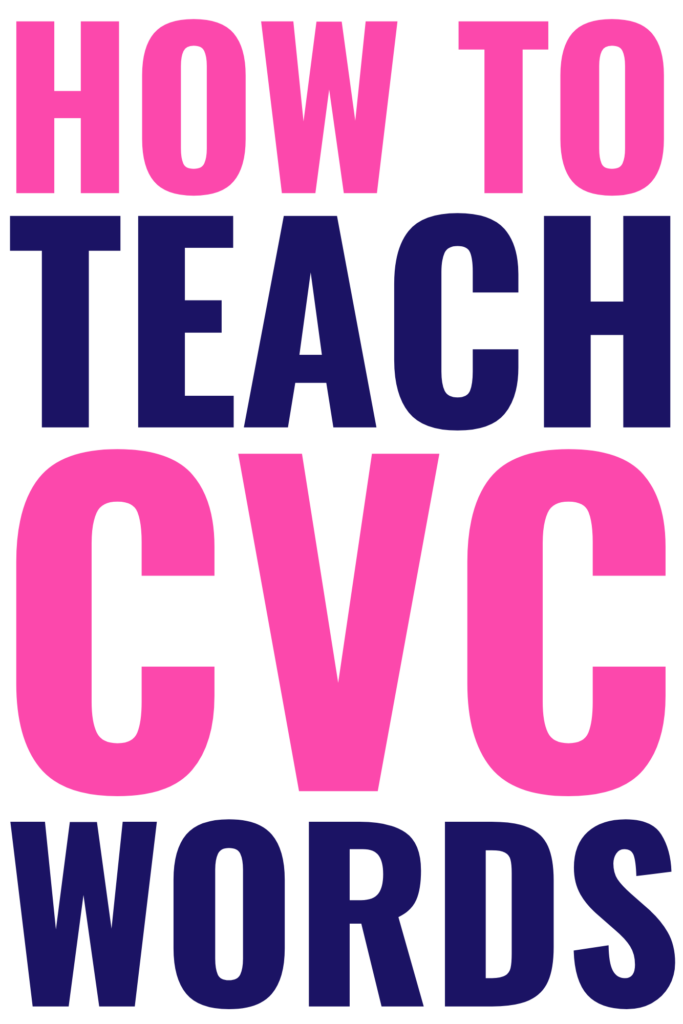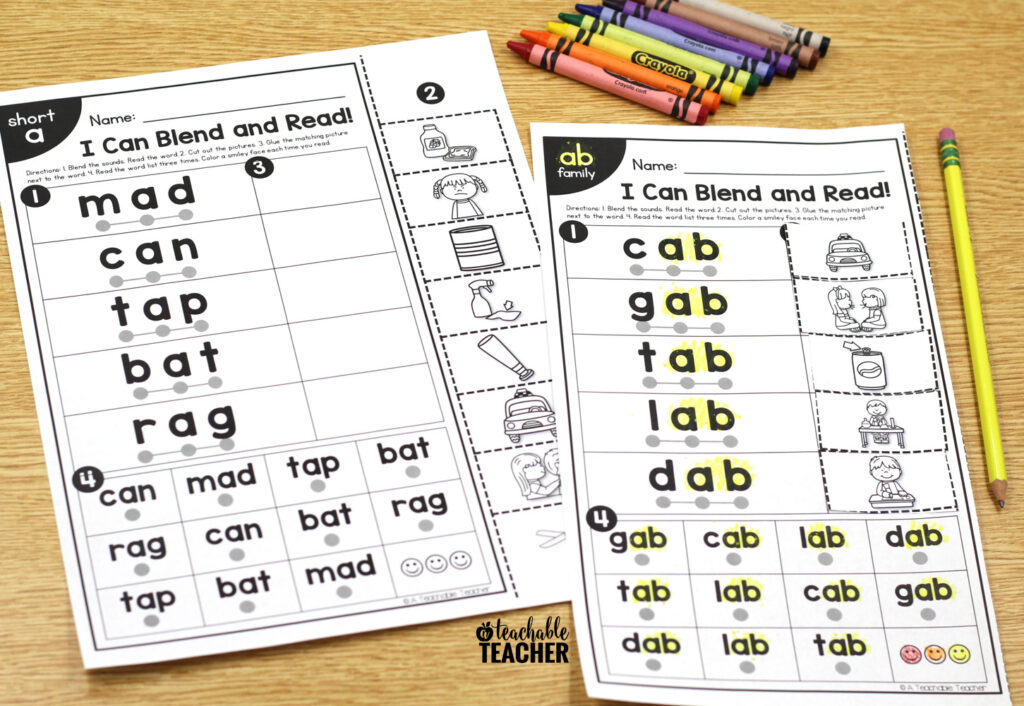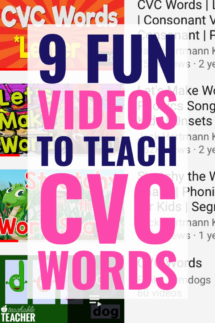If you’re wondering what CVC words are, or how to practice them in kindergarten, you’ve come to a great place. This blog post will teach you all about CVC words, provide different activities for practicing CVC words, and includes a free CVC word list.
*This post contains affiliate links. Rest assured we only recommend products we know and love, and using our link does not cost you anything extra. Thank you for supporting A Teachable Teacher.

What are CVC Words?
A CVC word is a single-syllable, three-letter word that consists of a consonant-vowel-consonant pattern.
(As you can see, consonant-vowel-consonant) is what CVC stands for.)
It’s important to note that in consonant-vowel-consonant words, the vowel is always a short vowel sound because it is a closed syllable.
(The syllable is closed because there is a consonant at the end).
CVC words will always be short vowel words.
The most “famous” example of a CVC word is the word cat.
| c | a | t |
The beginning sound of a CVC word will always be a consonant (the c in cat).
The middle sound of a CVC word will always be a vowel and it will always have the short sound (the a in cat).
The final sound or ending sound of a CVC word will always be a consonant (the t in cat).
Here are a few more examples of CVC words:
- bag
- cap
- mat
- zap
- red
- hen
- yet
- fib
- pig
- wig
- job
- fog
- hot
- gum
- sub
- nut
(You can find a full CVC word list pdf (as a free download) at the bottom of this post.)

What CVC Words are NOT:
Remember, not all short vowel words are CVC words.
For example, the word duck.
It only has 3 sounds. It starts with a consonant, has a medial short vowel, and the end of the word has a consonant.
However, that sound is represented by a digraph, which is two letters. Thus, the word duck is not a CVC word, it is a CVCC word.
Also, not all 3 letter words are CVC words.
For example, the word ask.
It has three letters and the short vowel sound. It is still a single closed syllable, too. However, it doesn’t follow the consonant-vowel-consonant pattern. Instead, it has a VCC pattern.
When do students learn CVC Words?
Honestly, too many people focus on what grade/age a child should be when they learn a new skill, like CVC words.
Yes, in the United States, CVC words are typically learned in Kindergarten.
However, that doesn’t really matter. What matters is if they already know what comes before learning CVC words.
This blog post will go into much more depth on the following, but here are important skills that students should know before learning CVC words:
- the difference between a letters and words
- some letters and their sounds (more info below)
- phonemic awareness (Students need to have the ability to hear the individual sounds in words. Being able to orally segment and blend words with three sounds is a good indicator that a student is ready to learn CVC words).
CVC words are important to beginning readers because it’s when they really start decoding words.
It’s an exciting time because it’s when the “I just read that!” lightbulb goes off in their head and they see themselves as a reader. (This was seriously my favorite part of teaching kindergarten.

Usually, the CVC words are the next step in reading and phonics after learning letter names and letter sounds.
(They can actually start to read CVC words before knowing ALL letter sounds. They only need to know a few consonant sounds and a few short vowel sounds in order to be able to read and write CVC words!)
Because of this, the most common time that young learners start to have CVC word phonics lessons is in kindergarten. However, they are still something that can be practice in first grade (and other grades, if the student is struggling to read).
Important Note: Students will struggle to blend, read, and write CVC words if they do not have a foundation in phonemic awareness. If you notice that a young reader is struggling to decode CVC words, go back to phonemic awareness. Have the student practice the oral blending of CVC words before having them try to decode a CVC word.
Because explicit and systematic phonics instruction is proven to be the most effective, I recommend explicitly teaching your students to identify CVC words be their letters and pattern – consonant, vowel, consonant.
My favorite way to do this is by co-creating an anchor chart with my students. Together with your students, add short vowel CVC words and draw a matching picture (or attach matching picture cards).
Types of CVC Words
While there are many CVC words that are real words, you can also mix vowels and consonants in the same consonant-vowel-consonant pattern to make nonsense words.
I like to include nonsense words practice, especially in assessments.
After having students decode a CVC word, I ask students to tell me if it’s a real word or a nonsense word.
Some teachers call them silly words, but let’s use academic vocabulary with our students – they can handle it!
Here are some examples of nonsense CVC words:
- bot
- yim
- paz
CVC Word Families
Have you ever heard of a CVC word family?
A word family is a group of words that has the same rime, but different onsets. (Don’t worry, I’ll explain!)

In the case of CVC words, the words in the same CVC word family will have a different beginning sound (first consonant) but the same vowel-consonant ending.
For example: bat, cat, fat, hat are all in the same CVC word family – the “at family.” Any other CVC words that end in -at are also in that family.
Often times, teachers will teach students word families to help them focus on beginning sounds.

This is also a good way to practice manipulating phonemes orally. (Example: The word is bat. Change the /b/ to /c/. What is the new word?) This is an essential skill in phonemic awareness, and one of the foundational skills in learning to read.
(Another reason that word families are good for kindergarten kids (or any young readers) is because word family words will rhyme.)
CVC Words & Simple Sight Words (High frequency words)
Did you know that a lot of high frequency words are actually CVC words? I learned this when I was reading and researching red words / heart words – a more effective way to teach high frequency words.
In fact, we don’t need to teach our students to memorize these words – they can sound them out!
Here are some examples of high frequency words that follow the CVC pattern:
- but
- can
- did
- get
- got
- had
- let
- not
- red
- yes
Ways to Practice CVC Words
There are so many ways to practice CVC words.
Building Phonemic Awareness for Reading CVC Words
Remember, if your students are struggling decoding (reading) or encoding (writing) CVC words, go back to phonemic awareness.
Practice CVC words orally (don’t add letters – yet) using sound boxes (elkonin boxes), or oral language games.

For example, use bingo chips and sound boxes. Have students slide of push a bingo chip into each box as they break up a word. To add even more fun – use magnetic bingo chips and a magnetic wand to remove all the chips after they finish the word. Repeat! (This is so much fun!)
You can build up to CVC words by focusing on beginning sounds, medial sounds, and final sounds in isolation.
Using Orthographic Mapping / Word Mapping to Practice CVC Words
A recent body of research known as The Science of Reading has shown the value in practicing orthographic mapping, or word mapping, to practice decoding and encoding words.

I highly recommend using word mapping to practice writing (encoding) cvc words.
(Click here to learn more about word mapping.)
CVC Words Activities for hands-on learning
I like introducing new CVC words activities in small groups before having young readers move onto doing them in a literacy center or as independent practice.
Working on CVC words is not a “one and done” lesson.
You should be continually reviewing CVC words in all modes of language – reading, writing, listening, and speaking. Remember to explicitly refer to the consonant, vowel, consonant pattern!
To throw in some extra learning during transition time or down times, check out these FREE CVC videos!
Some hands-on way to practice CVC words includes:
- Segmenting and blending CVC words audibly/with Elkonin boxes and/or manipulatives
- Word mapping CVC words
- CVC word cards – matching CVC words with pictures
- Building CVC words with magnetic letters
- CVC word mats

Downloadable & Printable CVC Words Activities
You can find many CVC words printable worksheets and books both in my website shop and my Teachers Pay Teachers store.
Click HERE for CVC printables & activities on Teachers Pay Teachers!Download your FREE List of CVC Words for Kindergarten
Enter your name and personal email address below to receive this FREE CVC Word List as an immediate download!

What do students learn AFTER CVC Words?
After students master CVC words, they typically move onto CCVC and CVCC words. The two consonants next to each other, in this case, will represent a digraph. For more information on digraphs, check back soon!











